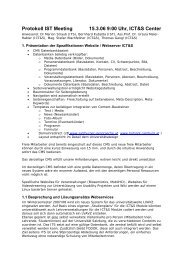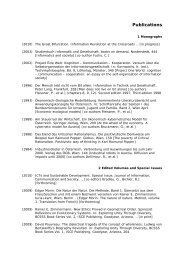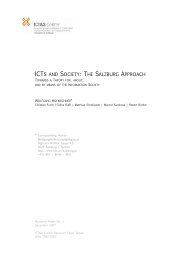CHRISTIAN FUCHS - ICT&S - Universität Salzburg
CHRISTIAN FUCHS - ICT&S - Universität Salzburg
CHRISTIAN FUCHS - ICT&S - Universität Salzburg
Create successful ePaper yourself
Turn your PDF publications into a flip-book with our unique Google optimized e-Paper software.
Christian Fuchs: Social Networking Sites and the Surveillance Societyplatform. This includes not only the platforms that boyd and Ellison have in mind, butalso chats, discussion boards, mailing lists, email, etc – all web 2.0 and 3.0technologies. Social network site is therefore an imprecise term. Such imprecision canarise from a lack of social theory foundations in SNS research: Definitions are givenwithout giving grounds to them. David Beer (2008b: 519) argues that the definition byboyd and Ellison is too broad and does not distinguish different types of sites such aswikis, folksonomies, mashups, and social networking sites. ”My argument here issimply that we should be moving toward more differentiated classifications of the newonline cultures not away from them”. He suggests to use web 2.0, not SNS, as anumbrella term.We agree with Beer and therefore consider it feasible to start from a theory of web 1.0,2.0, 3.0 (Fuchs 2008, 2009, Fuchs, Hofkirchner, Schafranek/Raffl, Sandoval & Bichler2008). Online platforms such as MySpace or Facebook are web-based platforms ofcommunication and community-building, i.e. not only web 1.0 systems, but also web2.0 and 3.0 systems. What makes them distinct is that they are integrated platforms thatcombine many media and information and communication technologies, such aswebpage, webmail, digital image, digital video, discussion group, guest book,connection list, or search engine. Many of these technologies are social network-toolsthemselves. It surely is feasible, as boyd and Ellison argue, that profiles, connectionlists, and tools for establishing connections are the central elements, but missing is theinsight that platforms such as Facebook are meta-communication technologies,technologies of communication technologies. Tim O’Reilly (2005b) argues in thiscontext that “the network as platform, spanning all connected devices” is a centraltechnological feature of web 2.0.We find it therefore more appropriate to speak of integrated social networking sites(ISNS). ISNS are web-based platforms that integrate different media, information andcommunication technologies, that allow at least the generation of profiles that displayinformation that describes the users, the display of connections (connection list), theestablishment of connections between users that are displayed on their connection lists,and the communication between users. ISNS are just like all computer technologiesweb 1.0 systems because they reflect and display dominant collective values of societythat become objectified and are confronting users. They are web 2.0 technologiesbecause they are used for communication and establishing connections in the form ofconnection lists. ISNS are web 3.0 technologies because they allow the establishmentof new friendships, communities, and the maintenance of existing friendships. Byfriendship we mean a continuous social relationship between humans that is based onempathy and sympathy. Therefore ISNS provide means for establishing virtualcommunities understood as “social aggregations that emerge from the Net whenenough people carry on those public discussions long enough, with sufficient humanfeeling, to form webs of personal relationship in cyberspace“ (Rheingold 2000, xx). ForRheingold, a virtual community is not the same as computer-mediated communication(CMC), but continuous CMC that results in feelings of affiliation.Not all social relations established or maintained on ISNS are forms of community.There might be superficial relations that just exist by a display of connection in theconnection list. This can be the case for example if one adds friends of friends whomone has never met and with whom one does not continuously interact, if one adds9









